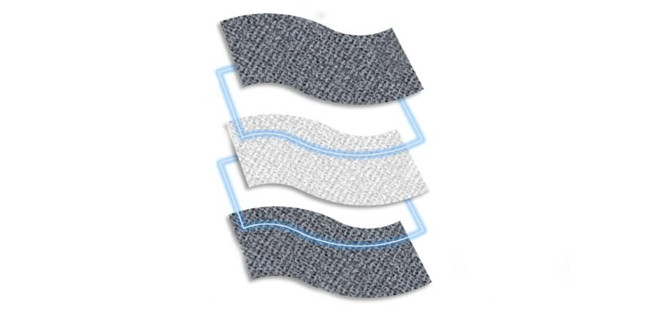Researchers Develop Graphene Inks for Wearable Electronics
| 16-09-2019 | By Rob Coppinger
Atom-thick sheets of carbon can be coated onto fabrics as inks to create batteries, avoiding the need for the toxic solvents that have been a barrier to the creation of wearable electronics.
Inks made of graphene, a two-dimensional form of carbon, single atoms thick, can now be coated onto polyester with a dyeing process to store electrical charge and discharge it when needed. The graphene inks are produced by standard solution processing techniques. The researchers claim that the versatility of the process will allow different types of electronic components to be woven into the ink coated fabric. By combining inks and overlaying different fabrics coated by these two-dimensional materials, flexible circuits for connecting electronic components can be created.

Credit: Felice Torrisi
“Other techniques to incorporate electronic components directly into textiles are expensive to produce and usually require toxic solvents, which makes them unsuitable to be worn,” said Imperial College chemistry department wearable bioelectronics lecturer, Felice Torrisi. “Our inks are cheap, safe and environmentally friendly, and can be combined to create electronic circuits by simply overlaying different fabrics made of two-dimensional materials on the fabric.” Before moving to Imperial College, Torrisi carried out this research at the University of Cambridge Graphene Centre.
The graphene ink technology is expected to find uses in a range of markets including personal health and well-being, wearable devices, data storage, military garments, and fashion.
Avoiding solvents
The Cambridge researchers start the coating process by suspending individual graphene sheets in a low boiling point solvent. This solvent, graphene mix is deposited on the polyester and the solvent is then removed through what is said by the researchers to be an easy process. The result is a polyester fabric with a thin and uniform conducting network that consists of all these single atom thick graphene sheets. This coated material is also superhydrophobic, meaning it will not absorb water.
By overlaying the graphene-coated fabric with another which is coated instead with hexagonal boron nitride creates what the researchers call an active region. This active region can store and discharge an electrical charge. This type of battery is flexible and can withstand washing cycles in a normal washing machine.
Torrisi and his colleagues worked with Jiangnan University in China. Jiangnan University’s professor Chaoxia Wang said: “Our result demonstrates for the first time that inks based on graphene and related materials can be used to produce textiles that could store and release energy. Our process is scalable and there are no fundamental obstacles to the technological development of wearable electronic devices.”
The research was supported by the UK government’s Engineering and Physical Science Research Council, the Trinity College charity the Isaac Newton Trust, the National Natural Science Foundation of China and the Ministry of Science and Technology of China. The technology is being commercialised by Cambridge Enterprise, the University’s commercialisation arm.
